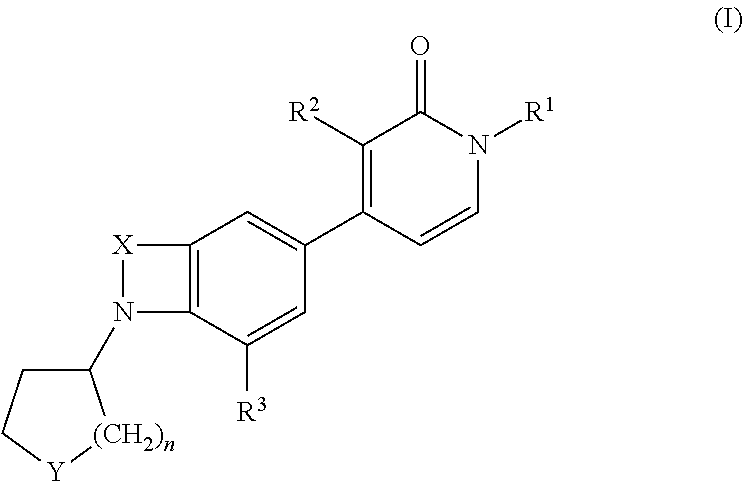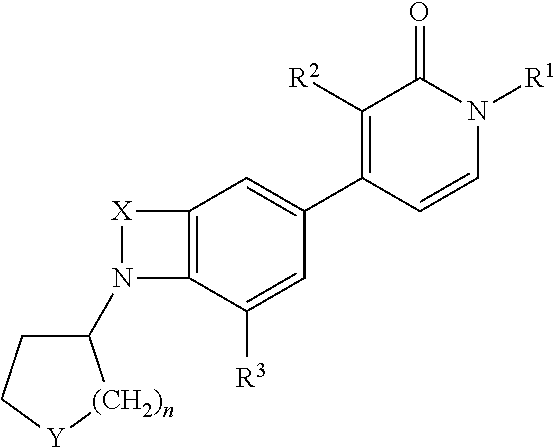Indole and benzomorpholine derivatives as modulators of metabotropic glutamate receptors
a technology of metabotropic glutamate receptor and derivative, which is applied in the direction of biocide, cardiovascular disorder, drug composition, etc., can solve problems such as glutamatergic neurotransmission imbalan
- Summary
- Abstract
- Description
- Claims
- Application Information
AI Technical Summary
Benefits of technology
Problems solved by technology
Method used
Image
Examples
example 1
1-Butyl-3-chloro-4-[4-(tetrahydro-pyran-4-yl)-3,4-dihydro-2H-benzo[1,4]oxazin-7-yl]-1H-pyridin-2-one (E1);
[0228]
[0229]A mixture of intermediate D16 (0.2 g, 0.348 mmol), intermediate D4 (0.116 g, 0.348 mmol), tetrakis(triphenylphosphine)palladium(0) (0.021 g, 0.0174 mmol) and an aqueous saturated NaHCO3 solution (1 ml) in dioxane (4 ml) was heated at 150° C. for 10 min. under microwave irradiation. After cooling to r.t., the r.m. was filtered through diatomaceous earth, treated with EtOAc and the organic layer was washed first with water and subsequently with brine. The organic fraction was dried (Na2SO4), filtered and the solvent was evaporated in vacuo. The crude residue was purified by column chromatography (silica gel; 0-10% EtOAc / DCM as eluent) followed by reversed phase HPLC on (C18 XBridge 19×100). A gradient was applied from 80% NH4CO3H pH 9, and 20% CH3CN to 0% NH4CO3H pH 9 and 100% CH3CN). The desired fractions were collected and evaporated in vacuo to yield E1 (0.059 g, 41...
example 2
trans-1-Butyl-3-chloro-4-[4-(4-hydroxy-cyclohexyl)-3,4-dihydro-2H-benzo[1,4]oxazin-7-yl]-1H-pyridin-2-one (E2);
[0232]
[0233]Sodium borohydride (2.507 mg, 0.0663 mmol) was added to a stirred mixture of intermediate D23 (0.025 g, 0.0603 mmol) in MeOH (2 ml) at r.t. The resulting r.m. was warmed to r.t. and stirred for 1 h. Subsequently, the mixture was washed with an aqueous saturated NaHCO3 solution and extracted with DCM. The separated organic layer was collected, dried (Na2SO4), filtered and the solvent was evaporated in vacuo. The residue was triturated with DIPE to yield E2 (20 mg) as a white solid.
[0234]M.P.: 178° C. 1 H NMR (400 MHz, C6D6) δ ppm 0.84 (t, J=7.3 Hz, 3 H), 1.00-1.12 (m, 2 H), 1.10-1.20 (m, 2 H), 1.20-1.32 (m, 2 H), 1.42 (br. s., 1 H), 1.48-1.58 (m, 4 H), 1.81-1.92 (m, 2 H), 2.68-2.78 (m, 2 H), 3.26-3.35 (m, 1 H), 3.35-3.45 (m, 1 H), 3.61 (t, J=7.4 Hz, 2 H), 3.85-3.91 (m, 2 H), 5.96 (d, J=6.9 Hz, 1 H), 6.28 (d, J=6.9 Hz, 1 H), 6.69 (d, J=8.8 Hz, 1 H), 7.36 (dd, J=8....
example 3
trans-1-Butyl-3-chloro-4-[1-(4-hydroxy-cyclohexyl)-1H-indol-5-yl]-1H-pyridin-2-one (E3);
[0235]
[0236]A mixture of intermediate trans-D20 (1 g, 2.93 mmol), intermediate D4 (0.815 g, 2.442 mmol), tetrakis(triphenylphosphine)palladium(0) (0.141 g, 0.122 mmol) and an aqueous saturated NaHCO3 solution (4 ml) in dioxane (12 ml) was heated at 150° C. for 7 min. under microwave irradiation. After cooling to r.t., the r.m. was filtered through diatomaceous earth, treated with EtOAc and the organic layer was first washed with water and then with brine. The organic fraction was dried (Na2SO4), filtered and the solvent was evaporated in vacuo. The crude residue was purified by column chromatography (silica gel; 0-10% heptane / EtOAc as eluent). The desired fractions were collected and evaporated in vacuo. The residue was triturated with diethyl ether. The white precipitate obtained was filtered off and dried in vacuo to yield E3 (0.506 g, 52%) as a white solid.
[0237]M.P.: 191.1° C. 1H NMR (500 MHz...
PUM
| Property | Measurement | Unit |
|---|---|---|
| temperature | aaaaa | aaaaa |
| temperature | aaaaa | aaaaa |
| temperature | aaaaa | aaaaa |
Abstract
Description
Claims
Application Information
 Login to View More
Login to View More - R&D
- Intellectual Property
- Life Sciences
- Materials
- Tech Scout
- Unparalleled Data Quality
- Higher Quality Content
- 60% Fewer Hallucinations
Browse by: Latest US Patents, China's latest patents, Technical Efficacy Thesaurus, Application Domain, Technology Topic, Popular Technical Reports.
© 2025 PatSnap. All rights reserved.Legal|Privacy policy|Modern Slavery Act Transparency Statement|Sitemap|About US| Contact US: help@patsnap.com



